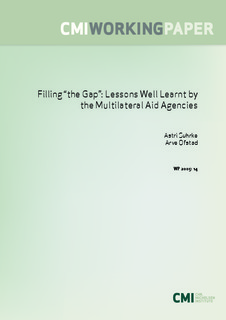| dc.contributor.author | Suhrke, Astri | |
| dc.contributor.author | Ofstad, Arve | |
| dc.date.accessioned | 2008-02-20T13:29:15Z | |
| dc.date.accessioned | 2017-03-29T09:12:42Z | |
| dc.date.available | 2008-02-20T13:29:15Z | |
| dc.date.available | 2017-03-29T09:12:42Z | |
| dc.date.issued | 2005 | |
| dc.identifier.isbn | 82-8062-128-8 | |
| dc.identifier.issn | 0804-3639 | |
| dc.identifier.uri | http://hdl.handle.net/11250/2435909 | |
| dc.description.abstract | An assumed gap between relief and development assistance was widely discussed in the 1990s. Urged to “mind the gap”, the multilateral aid agencies adjusted.
In terms of the initial learning phase - i.e. readiness to recognize a new set of problems and adjust objectives and programs accordingly - the agencies thus responded effectively. Functional adjustment was fostered by agency concern for their organizational standing, reinforced by inter-agency competition. Attempts by two agencies to forge a structured approach and create a regime to address “the gap” was neither successful, nor did it in the end prove necessary. The case suggests that inter-agency competition rather than cooperative regime-building is the easiest way to foster certain kinds of organizational learning. | |
| dc.language.iso | eng | |
| dc.publisher | Chr. Michelsen Institute | |
| dc.relation.ispartofseries | CMI Working paper | |
| dc.relation.ispartofseries | WP 2005: 14 | |
| dc.subject | Multilateral aid | |
| dc.subject | Development aid | |
| dc.subject | Humanitarian assistance | |
| dc.subject | International organizations | |
| dc.title | Filling "the Gap": Lessons Well Learnt by the Multilateral Aid Agencies | |
| dc.type | Working paper | |
